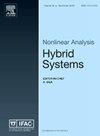Sure robust global versus robust global almost sure convergence: Implementing a dynamic random coefficient selection in a quaternion-hysteresis-based distributed hybrid algorithm
IF 3.7
2区 计算机科学
Q2 AUTOMATION & CONTROL SYSTEMS
引用次数: 0
Abstract
By employing Lyapunov-like conditions along with the stochastic invariance principle, we develop a quaternion-hysteresis-based distributed stochastic hybrid feedback algorithm aimed at achieving robust global attitude synchronization, addressing both sure and almost sure convergence. The distributed hybrid algorithm integrates a hybrid control variable that experiences continuous changes and instantaneous resets according to a unit quaternion-based reset rule and the associated hysteresis-based conditions. In this hysteresis-based hybrid framework, by treating the reset coefficients as random variables, these coefficients introduce the unique source of randomness; these coefficients are dynamically and randomly selected by the reset rule, leading to varying hysteresis half-widths and, consequently, different nominal levels of robustness; the orientation of the spring force, which reversely pulls the rigid body along the rotation axis to prevent the unwinding phenomenon, is determined by the deterministic sign of the hybrid control variable, whereas the hysteresis half-widths can delay this pulling. By dynamically and randomly adjusting the stochastic hysteresis half-widths, we create a flexible tradeoff between mitigating the amount of unwinding and enhancing the nominal level of robustness to measurement noise. By imposing different constraints on the support domain of random reset coefficients, the hybrid algorithm achieves both sure robust global and robust global almost sure attitude synchronization.
鲁棒全局与鲁棒全局几乎肯定收敛:在基于四元数-滞后的分布式混合算法中实现动态随机系数选择
通过采用类李雅普诺夫条件和随机不变性原理,我们开发了一种基于四元数-滞后的分布式随机混合反馈算法,旨在实现鲁棒的全球姿态同步,解决确定性和几乎确定性收敛问题。分布式混合算法集成了一个混合控制变量,该控制变量根据基于单位四元数的重置规则和相关的基于滞后的条件进行连续变化和瞬时重置。在这种基于迟滞的混合框架中,通过将重置系数作为随机变量处理,这些系数引入了唯一的随机性来源;这些系数是由重置规则动态和随机选择的,导致不同的滞后半宽度,因此,不同的名义鲁棒性水平;弹簧力的方向由混合控制变量的确定性符号决定,弹簧力沿着旋转轴反向拉动刚体以防止放卷现象,而滞后半宽度可以延迟这种拉动。通过动态和随机调整随机滞后半宽度,我们在减轻unwind量和增强对测量噪声的标称鲁棒性水平之间创建了一个灵活的权衡。通过对随机重置系数支持域施加不同的约束,混合算法实现了鲁棒全局和鲁棒全局几乎确定的姿态同步。
本文章由计算机程序翻译,如有差异,请以英文原文为准。
求助全文
约1分钟内获得全文
求助全文
来源期刊

Nonlinear Analysis-Hybrid Systems
AUTOMATION & CONTROL SYSTEMS-MATHEMATICS, APPLIED
CiteScore
8.30
自引率
9.50%
发文量
65
审稿时长
>12 weeks
期刊介绍:
Nonlinear Analysis: Hybrid Systems welcomes all important research and expository papers in any discipline. Papers that are principally concerned with the theory of hybrid systems should contain significant results indicating relevant applications. Papers that emphasize applications should consist of important real world models and illuminating techniques. Papers that interrelate various aspects of hybrid systems will be most welcome.
 求助内容:
求助内容: 应助结果提醒方式:
应助结果提醒方式:


